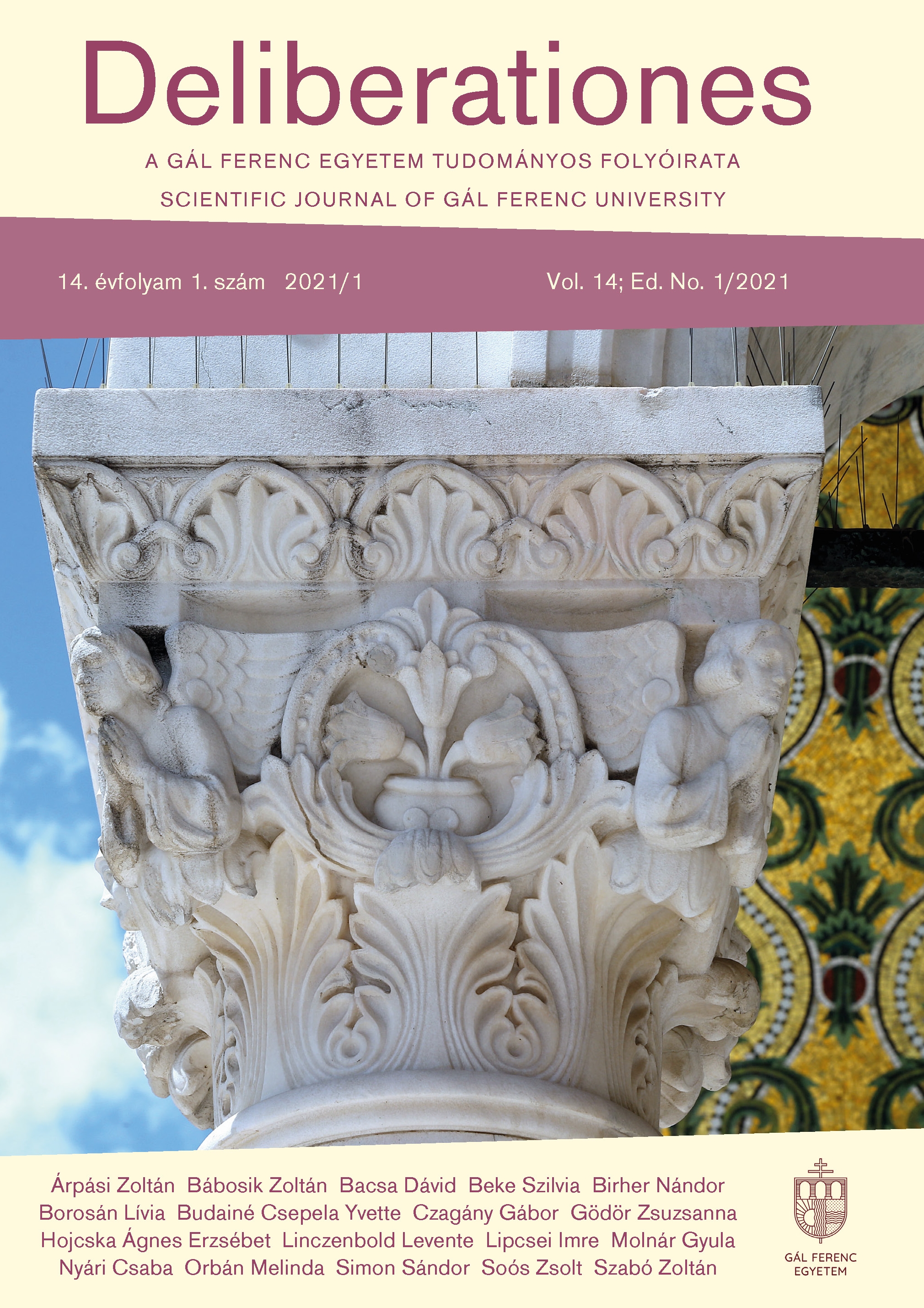Abstract
The focus of this study is on how to remove obstacles for the baptised and hearingimpaired people within the confession sacrament service practice of the Catholic Church. Hearing-impaired citizen’s language in Hungary is officially recognized, which allows the priests of the Church to communicate and transfer sacraments of confession through sign-language.
I examine those Church laws, where sign language translator can be employed and those non-verbal signs, on how the sacrament provider can identify the sacrament receiver’s preparedness and acceptance.
The apostolic Canon law, papal announcements, and the pastoral documents from United States Bishop Conference and their originated partial laws are examined in order to asses and introduce the hearing-impaired clear sacrament acquisition with
supplemented by my own experience.
It is also shown, how ordinary bishops can use these latin and the eastern partial laws in order to comply with hearing-impaired people baptised rights to receive the sacraments of confession the Church in a clear way.
References
Az igazságosság és béke pápai tanácsa. (2007). Az Egyház társadalmi tanításának kompendiuma. szent István Társulat. https://www.vatican.va/roman_curia/pontifical_councils/justpeace/documents/rc_pc_justpeace_doc_20060526_compendio-dott-soc_hu.html
Akach, O. (2015). Liturgy for the deaf congregation: Why a dedicated worship service.
University of Free state.
A Katolikus Egyház Katekizmusa. (2009). szent István Társulat. https://archiv. katolikus.hu/kek/
A klérus kongregációja. (1998). A katekézis általános direktóriuma. szent István
Társulat. https://regi.katolikus.hu/konyvtar.php?h=142 Atkinson, C. R., & Hilgard E. (2005). Pszichológia, Osiris Kiadó. Bánk, J. (1963). Kánoni jog II. szent István Társulat.
Budapest Főváros Kormányhivatala. (2020, január 8). A Jelnyelvi Tolmácsok Országos Névjegyzékébe felvett személyekről. https://www.kormanyhivatal.hu/download/3/ad/76000/Jelnyelvi%20Tolm%C3%A1csok%20Orsz%C3%A1gos%20N%C3%A9vjegyz%C3%A9ke.pdf
Calvi, M. (1999). Lugo e sede per la celebrazione del cacramento della penitenza. In Miragoli, E. (Ed.). (1999). Il sacramento della penitenza Il ministero del confessore: indicationi canoniche e pastorali. (225-232). Ancora.
Codex iuris canonici. (1951). Typis Polyglottis Vaticanis,
Congregatio pro Doctrina Fidei (1988). Urbis et orbis decretum. AAS 80. https://www.vatican.va/archive/aas/documents/AAs-80-1988-ocr.pdf
Cuschieri, A. (1992). The sacrament of Reconciliation. A theological and canonical treatise. Lanham.
Csizmadia, I. (2005) A pap szerepének hangsúlyváltozásai a bűnbánat szentségének liturgiatörténetében, Egri Hittudományi Főiskola.
Dennis, C. (2005). A tolmácsolás szociolingvisztikai modellje. Magyar Jelnyelvi
Programiroda.
Diós I. (Ed.). (2007). A II. Vatikáni Zsinat dokumentumai. szent István Társulat.
Erdő, P. (Ed.). (2015). Az Egyházi Törvénykönyv. A Codex Iuris Canonici hivatalos latin szövege magyar fordítással és magyarázattal. szent István Társulat.
Erdő, P. (2002). Rítusközi (egyházközi) gyóntatási fegyelem a katolikus egyházban.
Kánonjog, 2002(4)
Erdő, P. (2014). Egyházjog. szent István Társulat.
Henger, K. & Kollár, é. (2005). A jelnyelvi tolmácsolás etikája. Magyar Jelnyelvi Programiroda.
Hervada, J., & Lombardia, P. (1973). El derecho del Pueblo de Dios. Haica un sistema de derecho canonico 3/1. Derecho Matrimonial. Ediciones Universidad de Navarra.
II. János Pál (1981). AdhortatioapostolicaFamiliarisconsortio, AAS 74. https://www.vatican.va/archive/aas/documents/AAs-74-1982-ocr.pdf
Keppinger, B. (2013). Adalékok a „facultas” kifejezés jelentéséhez és használatához a
II. Vatikáni zsinat dokumentumaiban. Kánonjog, 2013(15)
Központi statisztikai Hivatal. (2014). A 2011. évi népszámlálás https://www.ksh.hu/docs/hun/xftp/idoszaki/nepsz2011/nepsz_11_2011.pdf
Lancz, E., & Berbeco, s. (2004). A magyar jelnyelv szótára. siketek és Nagyothallók
Országos szövetsége.
Magyar Országgyűlés. (2009). 2009. évi CXXV. törvény. https://net.jogtar.hu/jogszabaly?docid=a0900125.tv
Park, M. s. (2009). Deaf cultural and deaf church: consideration for pastoral ministry.
gallaudet University Press.
https://www.scd.org/sites/default/files/2017-07/deaf-culture-deaf-church.pdf Ribári O. (1986). Fül-Orr-Gégészet, Medicina Könyvkiadó.
Rincón-Pérez, T. (1999) Los derechos de los fieles y el sacramento de la penitencia (a propósito de dos notas recientes del pcitl). Ius Canonicum 1999(39)
Rihmer, z. (Ed.). (2012). A Keleti kódex - A keleti egyházak kánonjainak törvénykönyve.
szent Atanáz görög Katolikus Hittudományi Főiskola. https://www.nyirgorkat.hu/mediatar/dokumentumok/0001_Keleti_Kodex.pdf
Robertson, I. (2010). “Duc in altum:” A Model for Education in Ministry. Ephphatha!
The Deaf Person in the Life of the Church, 2010(1)
szabó, P. (2012.). A keleti egyházak Szentségi joga. szent Atanáz görögkatolikus
Hittudományi Főiskola. sINOsz. (2021). Siketség és jelnyelv.
https://sinosz.hu/siketseg-es-jelnyelv/ Utoljára ellenőrizve: 2020. 11. 25.
United state Conference of Catholic Bishops (2017, june 15). “Guidelines for the Celebration of the Sacraments with Persons with Disabilities.”. 70-71. https://www.usccb.org/committees/divine-worship/policies/guidelines-sacraments-persons-with-disabilities
Ujházi, L. (2008). gyermekek keresztelése és a keresztség „elhalasztásának” kérdése a hatályos jogban. Kánonjog, 2008(10)
Ujházi, L. (2009). A joghézag feloldásának lehetőségei az egyház hatályos jogában (CIC 19. kán). Kánonjog, 2009(11)
Vargas g. A. (2014). Hearing Loss and the Confessional.
https://www.audicus.com/hearing-loss-and-the-confessional/
Vinson J. (2015). The sacrament of penance: pastoral and inter-ritual difficulties regarding reserved sins and Latae sententiae cansures (Part 1). Iustitia, 2015(6)
WHO. (2020). Deafness and hearing loss.
https://www.who.int/news-room/fact-sheets/detail/deafness-and-hearing-loss Utoljára ellenőrizve: 2021. 08. 04.
yeng, P. J. (2010). The Challenges of Deaf Catholics in the Life of the Church.
Ephphatha! The Deaf Person in the Life of the Church, 2010(1)
